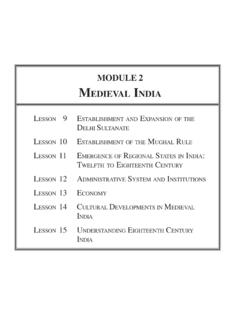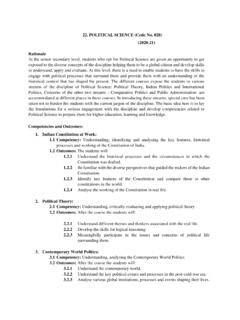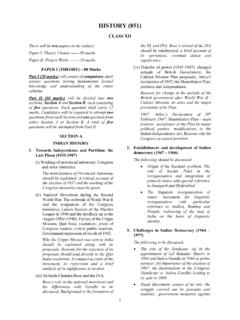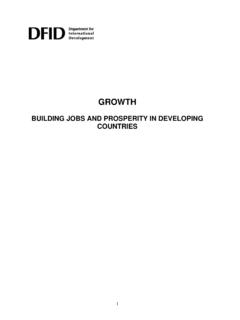Transcription of INDIA’S NATIONAL SECURITY STRATEGY
1 0 india S NATIONAL SECURITY STRATEGY MARCH 2019 PREFACE NATIONAL SECURITY is an all-encompassing term that includes the protection of a nation and its citizens from a range of multi-dimensional threats and coercion. The overwhelming scope of a STRATEGY to deal with these threats in a fast-evolving NATIONAL and international landscape is sometimes a hindrance in formalising a NATIONAL SECURITY STRATEGY '. However, a well-defined NATIONAL SECURITY STRATEGY is also a clear vision of the path that a nation should take in the pursuit of attaining its NATIONAL objectives. It also provides a guide for all organs of the state on the policy directions that they should follow. The lack of a formal NATIONAL SECURITY STRATEGY for india has been the subject of some criticism among the strategic community. Therefore, the initiative by the Indian NATIONAL Congress to commission this report deserves credit. This report will generate a broader discussion and help refine the contours of india s NATIONAL SECURITY STRATEGY .
2 In preparing this report, we neither ignore the strength of india 's growing power nor the difficulties that shackle us from achieving our real potential. We live in a time of considerable uncertainty, but what is certain is that the choices we make today will define our future place in the world. Each period in history comes with its unique set of challenges. We have attempted to suggest solutions to the SECURITY risks that india faces today. We do not seek to dissect history and dig into past missteps. We look to the future to see how it could be shaped to build a safer and more prosperous india . The preparation of this report owes a lot to the wisdom of many respected and experienced practitioners in the fields of governance, diplomacy, defence, internal SECURITY , intelligence, economics, media, and social sciences. Without their support, this report would not have been possible. However, the final copy is my work, and any shortfall rests on my shoulders.
3 Lt Gen D S Hooda (Retd) TABLE OF CONTENTS INTRODUCTION 1 ASSUMING OUR RIGHTFUL PLACE IN GLOBAL AFFAIRS 3 A Strategic Global Scan 3 Great Power Rivalry 3 Retreat of Multilateralism 4 The Middle East and North Africa 5 Navigating the Global Space 6 A Global Role 6 Bilateral Engagements 7 ACHIEVING A SECURE NEIGHBOURHOOD 10 A Troubled Neighbourhood 10 Ensuring Regional SECURITY 11 Engaging China 11 Dealing with Pakistan 12 Afghanistan 13 Cooperation in the Neighbourhood 13 Indian Ocean Region 14 PEACEFUL RESOLUTION OF INTERNAL CONFLICTS 16 Jammu and Kashmir 16 Mainstreaming Measures 17 The North East 19 Integrating the North East 19 Left Wing Extremism (LWE) 20 Tackling LWE 20 Transnational Terrorism 21 Combating Terrorism 22 PROTECTING OUR PEOPLE 23 Economic SECURITY 23 Climate Change and Environment 24 Demographic Pressures 26 Technology Disruption 26 Cyber Threats 27 Energy SECURITY 28 Policy Recommendations/Initiatives 29 STRENGTHENING OUR CAPABILITIES 31 Securing our Land and Maritime Borders 31 Strengthening Military Capability 33 Indigenisation of Defence Production 34 Transforming the Police 36 Intelligence 37 Cyber Warfare 38 Nuclear Forces 39 Space 40 Strategic Communications 40 CONCLUSION 41 1 INTRODUCTION he framing of a NATIONAL SECURITY STRATEGY must necessarily start with an examination of india s SECURITY objectives.
4 At the heart of this are the people of india and the character of the Indian state. india is home to one-sixth of the world's humanity, and its people aspire for a prosperous and safe future in which they can pursue their dreams without fear. This requires the state to create a conducive external and internal environment in which india occupies its due place in world affairs, is shielded from global and regional risks, and lives in peace. india s ancient history of cultural assimilation, her harmonious diversity, and our Constitution are strong guiding factors for a vision of the course that india must take. In achieving this vision, there are significant challenges. We are still home to more than 47 million people living in extreme poverty; we rate below the global average in gender equality, and our income inequality is among the highest in the world.
5 Unless these trends are reversed, we cannot achieve real SECURITY . We are mindful of the uncertain geopolitical environment in the world, threats of transnational terrorism, and our troubled neighbourhood. Globalisation is under pressure, and restrictive trade practices buffet the international landscape. The rise of nationalism is constraining migration flows and leading to policies of insulation and protectionism. This could have a serious impact on developing economies like india . We live in an uneasy neighbourhood. To our west and north, india has unsettled borders that could be a flashpoint for future conflicts, to our east there is a potential danger of refugee influx, and to our south is the Indian Ocean that is becoming an arena for strategic rivalry. There are continuing internal conflicts in parts of india that are increasingly playing out in social media with the prospective danger of dividing communities.
6 To ensure a secure and stable india that can guarantee safety and prosperity to its people, india 's NATIONAL SECURITY objectives could be defined as: Protecting india s NATIONAL sovereignty. T 2 Securing the territorial integrity of india . Promoting india s rise to its rightful place in international affairs. Ensuring a peaceful internal environment within india . Creating a climate for our citizens that is just, equitable, prosperous, and shields them from risks to life and livelihood. Flowing from these objectives are the tenets of our SECURITY STRATEGY . These tenets lay down our fundamental approach to achieving holistic NATIONAL SECURITY for india . These are, Assuming our Rightful Place in Global Affairs, Achieving a Secure Neighbourhood, Peaceful Resolution of Internal Conflicts, Protecting our People, and Strengthening our Capabilities. This NATIONAL SECURITY STRATEGY describes the path towards achievement of the fundamentals listed above.
7 No STRATEGY comes without risks and uncertainties, but the start point must be a clarity on the direction that we take. INTRODUCTION 3 ASSUMING OUR RIGHTFUL PLACE IN GLOBAL AFFAIRS A Strategic Global Scan Great Power Rivalry he current global strategic landscape is marked by a growing polarisation among the major powers - China, Russia, and the United States (US). The primary drivers of this polarisation are not ideological, but political and economic in nature. Individual major powers are attempting to assert their NATIONAL sovereignty by prioritising their unilateral policies over commitment to international cooperation. This strikes at the very heart of the structure of international relations created after the Second World War. The US has imposed sanctions against Russia for violating US laws against corrupt business practices in 2012, over Russia s annexation of Crimea in 2014, and, more recently, allegations of Russian involvement in cyber measures to influence the outcome of the US Presidential elections of 2016.
8 Russia has reciprocated with symbolic sanctions against the US and the European Union (EU), arguing that NATO s eastward expansion is contrary to the understanding that Russia had reached with the West for the reunification of Germany and the end of the Cold War in 1989. Russia s Greater Eurasia initiative of June 2016 seeks to reconstruct some of the former Soviet Union s inter-linkages through the creation of a Eurasian Economic Union bringing together Russia, Kazakhstan, Armenia, Kyrgyzstan, and Belarus. As China grows more powerful, its relationship with the US is becoming more tense. The US is in a trade war with China to lower tariffs on US exports and on alleged violations of US intellectual property rights. At the regional level, the US has unveiled an Indo-Pacific STRATEGY spearheaded by its Indo-Pacific Command (earlier Pacific Command) based in Hawaii.
9 The objective of this STRATEGY is to contain China in East and Southeast Asia. On its part, China has launched an ambitious "Belt and Road Initiative" (BRI). The BRI seeks to enhance China's dominance in economic relations with a vast number of countries, T 4 including many considered to be in the traditional spheres of influence of the US, EU, and Russia. While Russia and China have expanded their bilateral relations , the two powers are still wary of each other in strategic areas such as Central Asia and the Far East, where their interests compete. One result of great power rivalry has been the weakening of the moral framework for fighting global terrorism, with geopolitics and NATIONAL interests becoming the dominant factor. The US entry into Iraq in 2003 led to a complete destabilisation of the Middle East and the creation of the Islamic State.
10 The US-Russia competition in Syria has little to do with fighting terrorism but more to assert themselves in the region. In the process, they have directly and indirectly aided various terror groups. The Saudi Arabia intervention in Yemen is a manifestation of the larger Shia-Sunni conflict. Apart from the horrific humanitarian cost, one consequence of this conflict has been the strengthening of the al Qaeda in Yemen. Retreat of Multilateralism In terms of international peace and SECURITY , the most significant impact of this polarisation among the major powers has been on the effectiveness of the United Nations SECURITY Council (UNSC). The permanent membership of the five powers of the UNSC was justified in 1945 by their assertion of a special privilege for policing the world. The breakdown of international peace and SECURITY , with over million people displaced by violent conflict around the globe, illustrates the ineffectiveness of the UNSC vividly.










